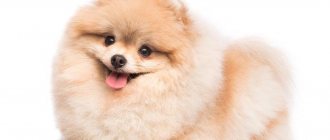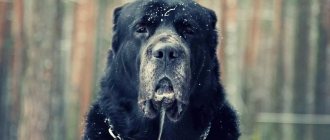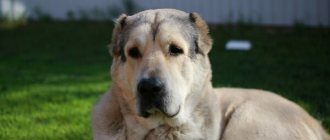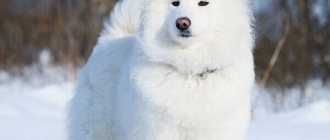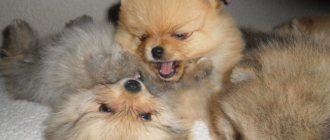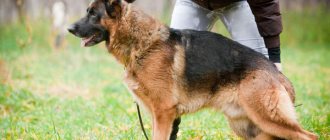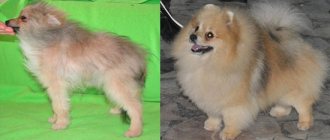Pomeranians are small, very beautiful and fluffy dogs that may appear somewhat larger due to their long and thick coat, which visually gives them additional volume.
It is very important for owners of such pets to know how much their Spitz weighs.
The size and weight of a dog is of considerable importance not only for an exhibition career, but also for the health of Pomeranians.
And, of course, puppy owners need to especially carefully monitor how their pet grows and develops.
Sizes for an adult dog depending on gender
Height at withers:
- Male - 20-22 cm
- Female – 18-20 cm
Body length:
The body of a Spitz is square, therefore, the length of its body should correspond to its height at the withers:
- Male - 20-22 cm
- Female – 18-20 cm
Expert opinion
Kozhevin Semyon Kirillovich
Expert dog handler.
“The height of the Pomeranian Spitz must be in the correct proportion to the weight and length of the body. These dogs have a square body, and therefore the length of the body should be equal to the height of the animal. Proper weight is of paramount importance for the health of Pomeranians. It’s okay if he’s a little larger or smaller than normal, but too much discrepancy between height and weight should raise red flags.”
Problems that may arise
- The dog's height is less than 18 cm. Such Spitz dogs have poor health, a weak nervous system, and thin and weak bones. Puppies need to be carefully monitored. Alas, such a dog will not be able to take part in the exhibition. She cannot participate in breeding either.
- The dog is taller than necessary. This can no longer be corrected. This is probably due to the presence of some large ancestor in the puppy’s pedigree, which influenced the size of the descendant.
- The Spitz is too small and thin, its weight is less than 1.3 kg. It is quite possible that this is not a pathology or a disease, but only a feature of the dog itself, but for such a miniature breed this plays an important role: these pets need to constantly measure their blood sugar levels, and they cannot jump from heights.
Puppy weight and sizes from 1 to 12 months
| Puppy age | Weight (depending on size variety) | Height at withers (average, for standard size dogs) | ||
| Dwarf | Mini | Standard | ||
| At birth | 70-95 grams | 105-125 grams | 130-140 grams | — |
| 1 month | 210-275 grams | 325-370 grams | 460-490 grams | 7-12 cm |
| 2 months | 320-460 grams | 550-620 grams | 680-770 grams | up to 14 cm |
| 3 months | 460-690 grams | 800-920 grams | 1.0-1.15 kg | up to 16 cm |
| 4 months | 600-880 grams | 1.0-1.175 kg | 1.3-1.45 kg | up to 17 cm |
| 5 months | 700-1030 grams | 1.2-1.35 kg | 1.55-1.7 kg | up to 18 cm |
| 6 months | 770-1150 grams | 1.3-1.5 kg | 1.7-1.9 kg | 18-20 |
| 1 year | 1.0-1.4 kg | 1.7-1.9 kg | 2.1-2.3 kg | 18-22 |
Because all puppies grow differently, babies of the same age up to 6 months old can have very different heights at the withers.
How to measure height correctly?
Having placed a puppy or an adult Pomeranian on the table, you need to attract its attention with a toy or treat. This is done so that the dog gets into a show stance.
After this, take a measuring tape and apply it to the animal’s withers, while its other edge remains hanging freely.
The size of the dog is determined by stretching a measuring tape to the tabletop on which the pet is standing . The distance from the Spitz's scruff to the surface on which the dog stands is its height at the withers.
There is another way to measure the height of an animal, but for this you will need to make a special device.
Take a long and fairly strong ruler with divisions all the way to the bottom, onto which a limiter is placed that moves freely along the length of the measuring device.
The height of the Spitz is measured by placing a ruler on a flat surface next to the dog, and the limiter is moved to the level of the withers..
Spitz nutrition
Pomeranian puppies are fed 3-4 times a day, and adults only twice. Half of your pet's diet should consist of meat products.
It is recommended to give 25 grams of food per kilogram of dog weight.
The main meat dishes are beef and chicken. Sea fish can be given no more than twice a day. Feeding with cereals (rice, buckwheat, oatmeal) is allowed.
In order for the animal to consume vitamins, it is recommended to add raw and boiled vegetables to the diet.
Cartilage is useful for a puppy. Beef and lamb cartilage improves the bite and trains the jaw muscles. But it is better not to give bones to dwarf breeds - they can injure the esophagus.
It is not recommended to buy bones for your dog in special stores. Soft toys and sticks with fluff will amuse your pet and exercise his muscles.
It is important to pay attention to your little friend so that he learns to obey his owners and does not become aggressive and disobedient.
Nutrition, health, visits to the veterinarian, walks and playing together are an integral part of a properly growing and developing purebred dog.
To what age do they grow?
Pomeranians belonging to different strains may grow differently . Representatives of some already at 4 months almost reach the height and weight of adult animals, while others gain the required size only by 9 months.
On average, Pomeranians are expected to reach full height up to 6 months, but then continue to gain weight for several months afterwards.
It should also be taken into account that the development of bitches may stop with the onset of the first emptying. Some Pomeranian girls, after the end of their first heat, no longer gain a centimeter in height.
The final physical development of a pet of this breed ends at 2-3 years: by this age, the Spitz not only fully grows in height, but also gains the required weight.
Coat type and color
The Dwarf Spitz has become so popular due to its coat. The Pomeranian Dwarf Spitz breed has a double coat: guard and down. The wool is elastic and very dense. On the body of the animal it is usually longer.
An adult dog has a well-developed collar. There may also be “pants” and “feathering”, which is observed on the back of the front legs. All Pomeranians go through a period when their coat looks unpresentable. This is usually typical during adolescence. For an adult animal, this type is considered a marriage. This characteristic of the breed is not known to many dog breeders.
Mini Spitz have fewer colors than those listed in the FCI standard.
The Pomeranian variety is often associated with the color red. However, they are also characterized by the following colors: black, zonal (gray), white, as well as orange, brown and cream. The most common are red and white Spitz, as well as gray dogs.
What affects the development of a puppy?
There are several factors that influence how quickly a Pomeranian puppy grows.:
- Heredity . Puppies from small parents, as a rule, are also born small. If one of the manufacturers was small, and the second almost grew to the upper limit of the standard, then options are possible. Babies from such litters can grow up to be both large and small. Considering that genes can go any way, none of the responsible breeders guarantees that this or that puppy will grow up to be small or, conversely, large. In addition, representatives of different lines gain height and weight differently, which also affects the growth rate of puppies.
- Quality of litter rearing . Conscientious breeders feed their babies the best food they can afford. Breeders often deliberately underfeed puppies so that they grow worse and look smaller. Subsequently, poor-quality feeding will inevitably affect the growth and development of the small Spitz, although, probably, over time it will be able to catch up in size with its peers.
- Feeding and maintenance. Depending on whether a growing orange eats natural food or prepared food, it will grow differently. Babies who are fed home-cooked food grow faster and already at 4-6 months reach the height and, sometimes, the weight of adult animals. When feeding dry food, the puppy will grow more slowly. But in the end, it will still reach the same size as when eating “natural” food. It's just that it will happen a little later.
- Vitamins . If you give your pet vitamin and mineral supplements, he will gain height and weight faster. But this does not mean at all that the Spitz will grow larger or heavier because of the vitamins. The exception is special supplements to increase muscle mass, which are contraindicated for Pomeranians in principle.
- Physical activity . Proportionate physical activity helps the puppy to develop properly. Such a Spitz probably won’t grow any larger than its littermates while away the time on the couch. But, unlike them, he will be more athletic and highly forward, which is why he will look taller and more proportional to them.
Serious diseases suffered during puppyhood can slow down or even stop the growth of a growing Spitz..
Spitz breed varieties
Spitz dogs are a large group of animals. All representatives of the breed have similar features: a narrow muzzle, pointed ears, fluffy fur and a curled tail. However, they differ in size and color, so they are divided into separate types.
The Pomeranian is probably the most beautiful and charming of all Spitz breeds. For this he was even given the nickname “Royal Spitz”. Thick fur with dense undercoat is a distinctive feature of animals. A smooth-haired dog will be out of breed.
Important. If you regularly cut off the luxurious fur at the root, the Pomeranian runs the risk of remaining short-haired forever.
The following types of Pomeranian Spitz are distinguished:
- Fox - distinguished by a narrow and elongated muzzle, which is very similar to a fox, well-furred cheeks, and pointed ears. The Pomeranian fox has a lighter bone structure, and its tail is longer than that of the “bear cub”.
- Teddy bear – has a flattened, wide muzzle. The chin is slightly raised, the tip of the nose is raised.
- Baby doll – the muzzle is quite wide, the rise is higher than that of “foxes”, but less than that of “bear cubs”.
Only the Fox-type Pomeranian meets the breed standard.
The Pomeranian belongs to a large group of breeds called Spitz-type dogs. They come in different sizes - large ones play the role of watchmen and shepherds, small ones have received a well-deserved reputation as decorative pets. The German Spitz breed standard includes the following types of Spitz:
- Wolfspitz (Keeshond) is the largest Spitz. Height ranges from 43 to 55 cm. It is distinguished by its characteristic wolf color.
- Grossspitz (large spitz) – grows up to 42–50 cm, can be black, chocolate or white.
- The Mittelspitz (medium Spitz) is a typical representative of the fox type. Height – 32–38 cm. The average Spitz has the same colors as Pomeranians.
- Kleinspitz (small Spitz) - 23–29 cm high. The range of shades is represented by black, brown, white and other colors.
Other species of the Spitz family:
- Japanese Spitz - combines the beautiful color of the Samoyed and the miniature size of the Pomeranian. Height is about 40 cm, weight is about 10 kg. Due to its similarity to the American Eskimo Dog, it is not recognized by the AKC.
- The American Eskimo Spitz, or Eskie, is a rare representative of the Spitz-like species. Wool can only be white or milky; other colors are discarded.
- The Eurasian Spitz is a cross between the German Wolfspitz and the Chow Chow. Grows up to 60 cm in height, weight does not exceed 30 kg.
- The Italian Spitz Volpino is a small dog with a height of 25–30 cm, originally from Italy. Allowed colors are snow-white, red or fawn. Volpino is a very rare breed that has been on the verge of extinction for a long time.
Due to their external similarity, sled dogs and hunting dogs are often classified as varieties of the Spitz dog breed:
- Greenland dog;
- Karelian-Finnish Laika (Finnish Spitz);
- Karelian Bear Dog or Karelian Bear Laika.
According to the RKF classification, they all belong to the same group, since they have common ancestors.
These are the most common types of Spitz. There are no such breeds as Irish or Russian Spitz. Unscrupulous owners sometimes try to pass off mixed-breed dogs as new varieties of Spitz.
What to do if your weight is below normal
A slight lag in weight from the norm (5-10% of body weight) is not an indicator of abnormal development of the puppy. The baby probably has lighter bones, or maybe he is simply not growing quite evenly: first he gains height, and then body weight.
The main criterion in this case should be the well-being and activity of the pet..
IMPORTANT!
When your puppy is cheerful, playful, and willing to learn new commands, there is usually nothing to worry about. If the ribs can be felt, but not too clearly, and the muscles are elastic and strong, then the dog is in good condition.
If the weight gap exceeds 10% of the recommended norm, then measures need to be taken. You may have to increase the calorie content of your food or change the brand of food.
If the lag in weight is due to improper rearing or the Pomeranian, as a puppy, suffered from something serious, you cannot do without consulting a veterinarian.
In some cases, increasing the duration of walks and the intensity of physical activity will also be useful, especially if the dog previously led a sedentary lifestyle..
In order to know exactly how the pet’s growing up process will proceed, it is recommended to ask the breeder about how the dogs of the lines to which the baby’s father and mother belong to grow and develop.
Temperament
The most important thing for a Spitz is its cheerfulness. He is always ready for any adventure, is happy to go for a walk and will support his owner in everything. The cheerful disposition and devotion make dogs of this breed the most preferable for friendship and protection.
Loud barking will notify you of the arrival of guests, and the joy from spending time together will be immeasurable.
A properly styled haircut looks elegant
